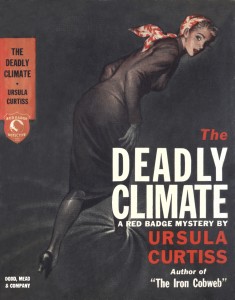 Every once in awhile, I crave a mushy sweet treat in book form. I won’t binge on romance novels, but I will choose a scrumptious looking title out of a box of Gothic sweets. This once popular genre was my diet for much of my preteen years. Newly married wives and mysterious possibly dangerous husbands were my bread and butter. A little older, I slightly changed my diet to mysteries with some romantic component, such as a husband and wife team, or an ill fated couple being kept apart by misunderstandings in the midst of murder, while the detective clears every thing up. And eventually, my tastes refined and romance was neither sought out, or rejected when choosing the next read. But some days the memory of a particularly delicious dessert title urges me to seek out a similar morsel, and when that occurs I wholeheartedly indulge.
Every once in awhile, I crave a mushy sweet treat in book form. I won’t binge on romance novels, but I will choose a scrumptious looking title out of a box of Gothic sweets. This once popular genre was my diet for much of my preteen years. Newly married wives and mysterious possibly dangerous husbands were my bread and butter. A little older, I slightly changed my diet to mysteries with some romantic component, such as a husband and wife team, or an ill fated couple being kept apart by misunderstandings in the midst of murder, while the detective clears every thing up. And eventually, my tastes refined and romance was neither sought out, or rejected when choosing the next read. But some days the memory of a particularly delicious dessert title urges me to seek out a similar morsel, and when that occurs I wholeheartedly indulge.
For those unfamiliar with what was considered ‘Gothics’ (apparently the word ‘romance’ was included, if so, I missed it) in the 60s and 70s, here’s my take on them. After Rebecca by Daphne du Maurier became such a gigantic hit, complete with Hitchcock film, writers started taking the bones of the story, young naive girl, handsome stranger, mysterious danger, and a huge estate complete with imposing forbidding house, and wrote the hell out of it–in those decades slim volumes seem to appear weekly. I would go to the local independent bookstore in the mall, and choose one or two titles at 65 or 75 cents a pop. Remember–people only made 2 to 300 bucks a week back then, so the books weren’t as cheap as they seem today. I’d also rummage through church, library, and flea market sales for everything I could find, and that’s where I ended up purchasing several Dell Mapbacks for 5 to 10 cents per copy. Some with romance, and most without–not because I’d moved on, but because the covers and maps on the back were so fantastic. And I’d carry away a armful of ‘desperate secrets’ and ‘innocent beauty’ plus ‘malevolent mansion.’
I recently read an article about Gothics explaining the house was the main subject and coveted prize within these books. The heroine gets the house, even if the man isn’t as cracked up to what he appeared to be. I agree,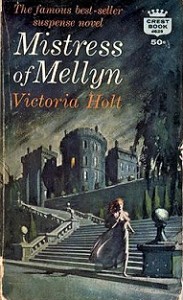 and disagree. There were plenty of plots where in the end the girl escapes with her life as she sees the house crumble, or burn, or blowup, or fall off the cliff it was invariably built upon. But the majority concluded with the heroine ensconced in a shadowy abode with the dark stranger, her husband, by her side.
and disagree. There were plenty of plots where in the end the girl escapes with her life as she sees the house crumble, or burn, or blowup, or fall off the cliff it was invariably built upon. But the majority concluded with the heroine ensconced in a shadowy abode with the dark stranger, her husband, by her side.
A couple of my favorite writers of the day were Victoria Holt, Phyllis A Whitney, Jane Aiken Hodge, Dorothy Eden and Barbara Michaels. When originally reading these books, I’d no understanding of pen names. I wouldn’t have known, for example, that Victoria Holt in reality was a woman named Eleanor Hibbert who had zillions of pseudonyms she wrote under, and which I’d probably read as well. Ms. Hibbert also wrote serious historical fiction involving the Tudors, Mary, Queen of Scots, Lucretia Borgia, and my favorite concept–the Spanish Inquisition–plus slews of others. She wrote non-fiction histories, and a couple of children’s books. She died as dramatically as she wrote–at sea! Two titles still stand out for me today, because I’m certain as a youth I read them more than once–The Mistress of Mellyn, and Bride of Pendorric. The former takes a gentlewoman in her mid twenties, unmarried, and with no money, becoming 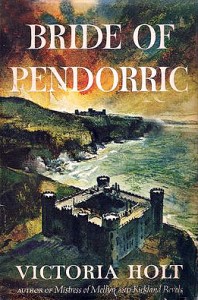 governess to a foreboding handsome man in his giant mansion. The latter is a twist on Rebecca (what wasn’t?) a young woman swept off her feet and in love is taken to a house in Cornwall where legend has it each young bride befalls death. The suspicious husband remains so throughout the book. The best part of Holt’s writing was the historical detail. I felt as though I’d stepped through a time warp and arrived as the governess just as the protagonist did. Her ability to hold suspense on such thin plots was remarkable.
governess to a foreboding handsome man in his giant mansion. The latter is a twist on Rebecca (what wasn’t?) a young woman swept off her feet and in love is taken to a house in Cornwall where legend has it each young bride befalls death. The suspicious husband remains so throughout the book. The best part of Holt’s writing was the historical detail. I felt as though I’d stepped through a time warp and arrived as the governess just as the protagonist did. Her ability to hold suspense on such thin plots was remarkable.
Phyllis A Whitney’s heroines traveled a great deal. Or more to the point, the books were set in various countries and locals. Yet, each one had a forbidding home. The best way to relate her style, is to show it:
“When Glen Chandler first removed the combs from Dina’s pale hair and said, “You’re my winter girl,” Dina seemed to surrender her will to him forever. She married Glen without even seeing High Towers, the remote Victorian estate whose windows, like eyes, still watched the lake where Glen’s mother had once drowned.” from the description The Winter People.
“Long before Sara came to San Francisco, the candle-lit figure in the mirror had haunted her dreams. But in the towering, old Varady mansion, where the sound of a kitten’s mewing could make a domineering woman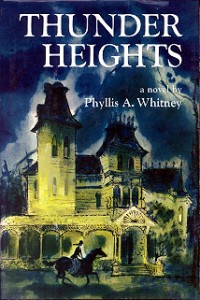 quake with fear, the nightmare turned into reality.” From the description of The Trembling Hills
quake with fear, the nightmare turned into reality.” From the description of The Trembling Hills
To Camilla King, her trip up the Hudson to the huge Gothic mansion named Thunder Heights was in a way a return to the home that had never been hers. From there her grandfather, Orrin Judd, the financier, ran his vast empire. When Camilla had been a child her mother had returned there for a visit and mysteriously died.” from the plot summary of Thunder Heights.”
And: “Jessica Abbott, fleeing her own past, finds herself the center of a whirlpool of conflict at Hampden House, high on its cliff in the Virgin Islands.” from plot summary of Columbella.
Notice the cliff? Notice all the dangerous houses mentioned? Notice how mothers have short lives? That in a nutshell sums up Whitney’s style, and her appeal. She is considered the master of romantic suspense by current practitioners, Mary Higgins Clark, and Elizabeth Peters, aka, Barbara Michaels. My favorite book of hers isn’t an adult Gothic, but a juvenile mystery I read when,well,a juvenile. The Haunted Pool:
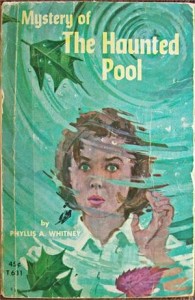 “Leaving her family in New York at the start of summer vacation, Susan Price comes up the river to the little town of Highland Crossing, where her aunt runs an antique shop. Aunt Edith has been working on a deal that, if successful, will permit the Price family and herself to live in the big house belonging to Captain Dan Teague.” Oh, brother, still a big old house!
“Leaving her family in New York at the start of summer vacation, Susan Price comes up the river to the little town of Highland Crossing, where her aunt runs an antique shop. Aunt Edith has been working on a deal that, if successful, will permit the Price family and herself to live in the big house belonging to Captain Dan Teague.” Oh, brother, still a big old house!
Ms. Whitney was bestowed the prestigious Grand Master award for life time excellence, from the Mystery Writers of America. I remember in the 90s seeing a new title with her name on it, and I sarcastically said, ‘yeah right, she wrote it–she’d have to be like, 100!’ Well, she died–at 104!
Jane Aiken Hodge (I tend to mix her up with her sister, Joan Hodge, who also wrote) and Dorothy Eden are less burned in my memory, but I certainly know I read and enjoyed many of their titles. Dorothy Eden’s The Pretty Ones summary:
“When newly-wed Emma begins to hear unpleasant rumours about her husband – about his ex-wife and a governess that disappeared without cause or explanation – her suspicion turns to cold fear as a lonely grave is discovered in a nearby field.”
Joan Aiken Hodge’s Marry in Haste: “Camilla Forest finds herself alone on a muddy road, left to fend for 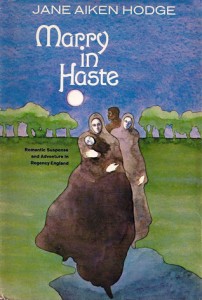 herself, when the carriage of Lord Leominster pulls up alongside. This sets off an agreement to a marriage of convenience with Camilla and Lavenham, the Lord. They move to Portugal, along with his sister, Chloe. Camilla finds herself falling in love with her husband.” My feelings are if reread today, I may find these two authors’ work, lacking.
herself, when the carriage of Lord Leominster pulls up alongside. This sets off an agreement to a marriage of convenience with Camilla and Lavenham, the Lord. They move to Portugal, along with his sister, Chloe. Camilla finds herself falling in love with her husband.” My feelings are if reread today, I may find these two authors’ work, lacking.
Barbara Michaels I read today. Her Gothics have less to do with romance and big houses and more to do with the supernatural. Her style can chill you. There is genuine suspense in each title, and I look forward to the creeps she delivers. She is also the best selling author of the Egyptology mysteries starring Amelia Peabody. However, my favorite title of hers is Naked Once More with Jacqueline Kirby. Here’s how Elizabeth Mertz’s (the author’s actual name) describes her protagonist: “Jacqueline Kirby (known as “Jake” to her friends), a librarian turned romance novelist, enjoys nothing more than people who take themselves way too seriously. Whether it is history buffs exploring ancient Roman ruins or a convention of romance writers, Jacqueline enters into the spirit of the group. Her fellow enthusiasts are never quite sure whether Jacqueline is a new convert, or an amused observer of their 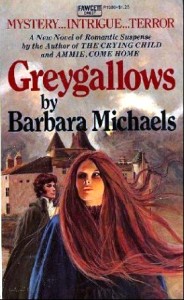 eccentricities.” I may need to include Naked Once More in my Best 100 Mysteries of All Time, now that I’ve been reminded of this hilarious send up of the romance and writing community.
eccentricities.” I may need to include Naked Once More in my Best 100 Mysteries of All Time, now that I’ve been reminded of this hilarious send up of the romance and writing community.
So which of these splendid authors did I pick out of the chocolate box to savor? None of them–I grabbed the first thing at hand–a book by Ursula Curtiss–The Deadly Climate. It involves a house, but that’s the end of similarity to Gothics. It’s a wonderful atmospheric suspense story of a young woman, yes, jilted, yes, but there is no romance per say within the rest of the novel-just the girl trying to survive after witnessing a murder in a foggy secluded forest. She finds refuge within a home she finally comes upon, but whether or not she’s safe, is another matter. The Deadly Climate not only satisfied my sweet tooth, but supplied a truly creepy, scary suspenseful meal.
Ursula Curtis is the sister of fellow crime fiction novelist, Mary McMullen, and the daughter of acclaimed mystery writer and one of my favorite authors, Helen Reilly, who didn’t write Gothics.
http://en.wikipedia.org/wiki/Eleanor_Hibbert
http://www.phyllisawhitney.com/

Diane, I finds your posts such as this one to be a great resource to fill my mind and amaze (or bore) my friends with how smart I am. Only job I have is to remember what you wrote. Good one again. Thanks – Paul
Paul, you are very sweet and kind. Certainly my articles may bore your friends, lol, on the other hand, you never know who may be riveted by Victoria Holt, lol.